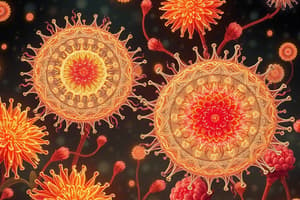Podcast
Questions and Answers
What is the basic unit of all known organisms?
What is the basic unit of all known organisms?
- Biomolecules
- Proteins
- Organelles
- Cells (correct)
What is the difference between eukaryotic and prokaryotic cells?
What is the difference between eukaryotic and prokaryotic cells?
- Eukaryotic cells have a nucleus, while prokaryotic cells do not have a nucleus (correct)
- Eukaryotic cells do not have a cytoplasm, while prokaryotic cells have a cytoplasm
- Prokaryotic cells have a nucleus, while eukaryotic cells do not have a nucleus
- Prokaryotic cells do not have a cytoplasm, while eukaryotic cells have a cytoplasm
What is the process of duplicating a cell's genome called?
What is the process of duplicating a cell's genome called?
- DNA repair
- Cell metabolism
- Protein synthesis
- Replication (correct)
What are organelles in a cell analogous to?
What are organelles in a cell analogous to?
What is the process by which individual cells process nutrient molecules called?
What is the process by which individual cells process nutrient molecules called?
What is the molecule that possesses readily available energy and is made by breaking down glucose in cells?
What is the molecule that possesses readily available energy and is made by breaking down glucose in cells?
What is the earliest self-replicating molecule thought to be?
What is the earliest self-replicating molecule thought to be?
What is the process of constructing complex molecules and performing other biological functions called?
What is the process of constructing complex molecules and performing other biological functions called?
What is the difference between unicellular and multicellular organisms?
What is the difference between unicellular and multicellular organisms?
Flashcards
What is a Cell?
What is a Cell?
Basic unit of all known organisms, enclosed by a membrane, containing biomolecules.
Cell functions
Cell functions
Cells can acquire specified functions such as replication, DNA repair, protein synthesis, and motility.
Eukaryotic Cell
Eukaryotic Cell
Type of cells with a nucleus.
Prokaryotic Cell
Prokaryotic Cell
Signup and view all the flashcards
Cytoskeleton
Cytoskeleton
Signup and view all the flashcards
Organelles
Organelles
Signup and view all the flashcards
DNA Replication
DNA Replication
Signup and view all the flashcards
Catabolism
Catabolism
Signup and view all the flashcards
Anabolism
Anabolism
Signup and view all the flashcards
Study Notes
The Cell: A Summary of its Structure, Types, and Processes
-
The cell is the basic unit of all known organisms, consisting of a cytoplasm enclosed within a membrane and contains many biomolecules such as proteins, DNA and RNA, as well as many small molecules of nutrients and metabolites.
-
Cells can acquire specified functions and carry out various tasks within the cell such as replication, DNA repair, protein synthesis, and motility and are capable of specialization and mobility within the cell.
-
Most plant and animal cells are only visible under a light microscope, with dimensions between 1 and 100 micrometres, and organisms can be classified as unicellular or multicellular.
-
Cells emerged on Earth about 4 billion years ago, and the study of cells and how they work has led to many other studies in related areas of biology, including discovery of DNA, cancer systems biology, aging, and developmental biology.
-
Cells are of two types: eukaryotic, which contain a nucleus, and prokaryotic cells, which do not have a nucleus but have a nucleoid region.
-
Prokaryotic cells include bacteria and archaea, and eukaryotic cells include plants, animals, fungi, slime molds, protozoa, and algae.
-
The cytoskeleton acts to organize and maintain the cell's shape, anchor organelles in place, help during endocytosis and cytokinesis, and move parts of the cell in processes of growth and mobility.
-
The genetic material of cells includes deoxyribonucleic acid (DNA) and ribonucleic acid (RNA), which is used for information transport and enzymatic functions.
-
Organelles are parts of the cell that are adapted and/or specialized for carrying out one or more vital functions, analogous to the organs of the human body, and both eukaryotic and prokaryotic cells have organelles, but prokaryotic organelles are generally simpler and are not membrane-bound.
-
Many cells have structures outside the cell membrane, such as a cell wall, capsule, flagella, or fimbriae, which are notable because they are not protected from the external environment by the semipermeable cell membrane.
-
Cellular processes include replication, DNA repair, growth, and metabolism, which have evolved in organisms ranging from bacteria to humans.
-
DNA replication, or the process of duplicating a cell's genome, always happens when a cell divides through mitosis or binary fission, and DNA repair processes have evolved in all organisms to maintain cellular DNA in an undamaged state.
-
Cell metabolism is the process by which individual cells process nutrient molecules, and has two distinct divisions: catabolism, in which the cell breaks down complex molecules to produce energy and reducing power, and anabolism, in which the cell uses energy and reducing power to construct complex molecules and perform other biological functions.Cell Biology: An Overview
-
Cells break down glucose to make ATP, a molecule that possesses readily available energy.
-
Protein synthesis involves the formation of new protein molecules from amino acid building blocks based on information encoded in DNA/RNA.
-
Cell motility involves many receptors, proteins, and cytoskeletal contraction to pull the cell forward.
-
Cells are able to navigate efficiently through a body and identify the best routes through complex mazes by generating gradients after breaking down diffused chemoattractants.
-
In multicellular organisms, cells specialize into different cell types that are adapted to particular functions.
-
Multicellularity has evolved independently at least 25 times and complex multicellular organisms evolved only in six eukaryotic groups.
-
The first evidence of multicellularity is from cyanobacteria-like organisms that lived between 3 and 3.5 billion years ago.
-
The origin of cells has to do with the origin of life, which began the history of life on Earth.
-
RNA is thought to be the earliest self-replicating molecule, as it is capable of both storing genetic information and catalyzing chemical reactions.
-
The eukaryotic cell seems to have evolved from a symbiotic community of prokaryotic cells.
-
There is still considerable debate about whether organelles like the hydrogenosome predated the origin of mitochondria.
-
Cell biology research involves studying the structure and function of cells, as well as their interactions with their environment and other cells.
Studying That Suits You
Use AI to generate personalized quizzes and flashcards to suit your learning preferences.




